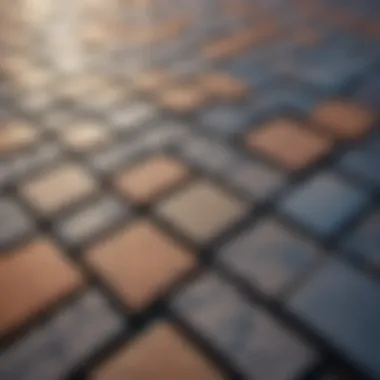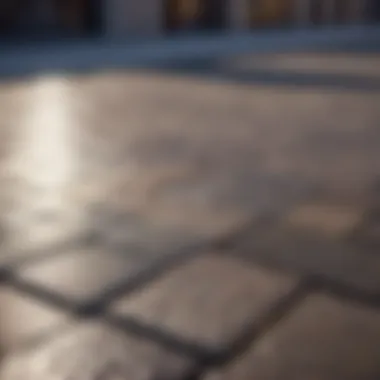Materials:
- Paving stones: 100 sq. ft. of natural stone measuring 12x12 inches each
- Gravel base material: 4 inches in depth covering the entire area
- Sand bedding: 1 inch in thickness for even surface
- Edging material: 12 linear feet of sturdy plastic or metal border
- Landscape fabric: 100 sq. ft. to prevent weed growth
- Jointing sand: 1 bag to fill gaps between stones
DIY Steps:
- Prepare the Site: Measure and mark the area for excavation, ensuring it is level and compacted.
- Excavation: Dig out the area to a depth of 6 inches, allowing for 4 inches of base and 1 inch of sand.
- Base Preparation: Lay gravel evenly, compacting it to create a stable foundation.
- Sand Bedding: Spread sand over the gravel, leveling it for the stones to sit uniformly.
- Stone Placement: Arrange paving stones in desired pattern, starting from the center and working outwards.
- Edging Installation: Secure the perimeter with edging material to prevent shifting.
- Jointing: Fill gaps between stones with jointing sand, sweeping off excess.
- Finishing Touches: Compact the entire surface and water the area to set the stones.
Technical Aspects:
- Tools: Shovel, wheelbarrow, compactor, level, rubber mallet, broom
- Timing: Estimated completion time of 1-2 days depending on area size
- Techniques: Ensuring proper drainage, compacting materials for stability, aligning stones accurately
DIY Project Process:


- Step 1: Begin by preparing the site meticulously, following measurements precisely to avoid errors during installation.
- Step 2: As you excavate, take caution to create a level surface to prevent unevenness in the final result.
- Step 3: Properly compacting the base material is crucial for long-term durability and to prevent shifting of the stones.
- Step 4: Carefully laying the sand bedding ensures a smooth and stable foundation for the paving stones.
- Step 5: When placing stones, pay close attention to alignment and spacing for a professional finish.
- Step 6: The edging material not only adds a decorative touch but also serves a functional purpose in maintaining the structure.
- Step 7: Thoroughly brushing and compacting the surface promotes settling and secures the stones in place.
Troubleshooting Tips:


- If stones shift, readjust and add more jointing sand to secure them.
- In case of drainage issues, reassess the base and make adjustments for proper water flow.
- For weed growth, ensure the landscape fabric is correctly installed to prevent vegetation breakthroughs.
Factors Influencing Pricing


Material Quality
Grade of the Stone
Durability and Longevity
Another essential factor in material quality is the durability and longevity of the paving stone. Durable stones are crucial for outdoor applications where they are exposed to various weather conditions and foot traffic. Longevity plays a vital role in determining the overall value of the investment, as stones that can stand the test of time require less maintenance and replacement, ultimately translating to cost-effectiveness. By choosing paving stones known for their durability and longevity, homeowners can ensure a lasting and high-quality solution for their outdoor spaces, adding both aesthetic appeal and functional value to their properties.
Design Complexity
Intricate Patterns
The design complexity of paving stones also influences pricing considerations. Intricate patterns in paving stones can add a touch of elegance and uniqueness to outdoor spaces but often come at a higher cost due to the craftsmanship and precision required during installation. Intricate patterns involve precise cutting and placement of stones, making them a popular choice for homeowners looking to create visually stunning pathways or patios. While the cost of intricate patterns may be higher compared to simpler designs, the aesthetic impact and customization options they offer can significantly enhance the overall appeal of outdoor areas.
Custom Cuts
Custom cuts in paving stones allow for personalized designs that cater to specific preferences and spatial requirements. Custom-cut stones give homeowners the freedom to create bespoke patterns or shapes that align with their design vision and functional needs. While custom cuts involve additional labor and material costs, they provide a tailored solution that sets the outdoor space apart from standard designs. By incorporating custom cuts into paving stone projects, homeowners can achieve a distinctive look that reflects their individual style and elevates the overall aesthetics of their outdoor environments.
Market Demand
Seasonal Variations
Seasonal variations impact the pricing of paving stones due to fluctuations in demand and supply throughout the year. During peak seasons, such as spring and summer, where outdoor renovation projects are popular, the demand for paving stones increases, leading to potential price escalations. Understanding seasonal variations is essential for homeowners planning paving stone installations to anticipate potential cost changes and schedule their projects accordingly to optimize budget management.
Local Trends
Local trends also play a significant role in pricing dynamics for paving stones. Regional preferences, design styles, and material choices can influence the cost of paving stones based on what is popular or sought after in a particular area. Being aware of local trends enables homeowners to make informed decisions regarding their paving stone selections, aligning their choices with prevailing styles and preferences to enhance the aesthetic appeal and resale value of their properties.
This detailed exploration of factors influencing pricing in the context of paving stones per square foot provides valuable insights into the importance of material quality, design complexity, and market demand when making cost-effective decisions for outdoor projects.
Types of Paving Stones
When delving into the realm of paving stones, one must first grasp the significance of the various types available. The choice of paving stones plays a pivotal role in influencing not only the aesthetic appeal of the outdoor space but also the overall cost considerations. Different types of paving stones offer distinctive characteristics, benefits, and considerations that cater to specific needs and preferences. Understanding the nuances of interlocking concrete pavers, natural stone pavers, and brick pavers provides homeowners and housewives with the necessary insights to make informed decisions when embarking on a paving project.
Interlocking Concrete Pavers
Interlocking concrete pavers stand out as a popular choice in the realm of landscaping due to their durability, versatility, and aesthetic appeal. The benefits of interlocking concrete pavers include ease of installation, low maintenance requirements, and a wide range of design options. These pavers are known for their ability to withstand varying weather conditions and heavy foot traffic, making them a practical and long-lasting solution for both residential and commercial spaces.
Benefits
Interlocking concrete pavers offer a versatile and cost-effective paving solution for homeowners looking to enhance their outdoor living areas. The key characteristic of these pavers lies in their interlocking design, which ensures stability and uniformity once installed. The unique feature of interlocking concrete pavers is their ability to be easily replaced if damaged, providing a convenient and sustainable paving solution. While they require a higher initial investment compared to other options, their longevity and minimal upkeep make them a worthwhile choice for those seeking a durable and visually appealing outdoor space.
Drawbacks
Despite their many advantages, interlocking concrete pavers do come with some drawbacks. One notable downside is their initial cost, which may deter some homeowners on a strict budget. Additionally, the installation process can be labor-intensive, especially for DIY enthusiasts with limited experience in landscaping projects. It is essential to weigh these drawbacks against the benefits to determine if interlocking concrete pavers align with your specific needs and budget.
Average Cost
The average cost of interlocking concrete pavers typically ranges from X to Y per square foot, depending on the quality of the material, the complexity of the design, and the labor expenses involved. While this cost may seem higher upfront, the long-term savings in maintenance and replacement make interlocking concrete pavers a cost-effective investment for those seeking a durable and visually appealing outdoor space.
Installation Expenses
When it comes to the overall cost of paving stones per square foot, installation expenses play a significant role in the budgeting process. Understanding the intricacies of installation costs is crucial for homeowners and housewives alike, as it can greatly impact the final pricing of a project. Various elements contribute to installation expenses, including labor costs and additional materials. Proper planning and allocation of budget towards installation are essential in creating a durable and aesthetically pleasing paved surface.
Labor Costs
Labor costs are a key component of installation expenses. Professional installation services offer expertise and efficiency in laying down paving stones, ensuring a high-quality finish that meets industry standards. Opting for professional installation can save time and effort for homeowners, especially those with limited experience in such projects. While it may entail a higher upfront cost, the expertise and skill provided by professionals can result in a more durable and visually appealing outcome.
DIY Options
On the other hand, some homeowners may choose the do-it-yourself (DIY) route to cut down on labor costs. DIY options can be a cost-effective choice for individuals who possess the necessary skills and equipment to undertake the installation process themselves. While DIY projects can offer a sense of accomplishment and potential cost savings, they also come with risks such as improper installation leading to future repairs. It is essential to weigh the benefits and challenges of DIY options before embarking on a paving stone project.
Additional Materials
Apart from labor costs, additional materials play a vital role in the installation of paving stones. Proper base preparation is crucial for creating a stable foundation that prevents shifting and unevenness in the paved surface over time. From compacting the soil to laying down gravel and sand, base preparation is essential for the longevity of the pavement. Edging also serves a functional and aesthetic purpose, defining the boundaries of the paved area and providing stability to the structure. Choosing the right edging materials can enhance the overall look of the project while ensuring structural integrity.
Base Preparation
Base preparation involves the initial groundwork necessary for a successful paving stone installation. It includes processes such as excavation, compaction, and proper leveling to create a solid base for the stones. The quality of base preparation directly impacts the durability and longevity of the paved surface, making it a crucial step in the installation process. While it may add to the overall expenses, investing in quality base preparation is essential for a lasting and stable pavement.
Edging
Edging plays a dual role in paving stone projects, acting as both a visual boundary and a structural support. Edging materials can range from plastic, metal, to natural stone, each offering unique benefits in terms of aesthetics and functionality. Proper edging prevents the displacement of paving stones, maintaining the integrity of the surface and enhancing its durability. Selecting the right edging material based on the design aesthetic and functional requirements of the project is essential for a successful installation.
Maintenance Considerations
Proper maintenance not only enhances the visual appeal of your outdoor space but also ensures the structural integrity of the paving stones. Factors such as sealing, cleaning, and repairs play a significant role in preserving the quality and durability of the paved surface. By addressing maintenance considerations proactively, homeowners can enjoy a beautiful and functional paved area for years to come.
Sealing
Frequency
Sealing is a critical maintenance task that significantly impacts the overall condition of your paving stones. The frequency of sealing depends on various factors such as environmental exposure, foot traffic, and the type of paving material used. Regularly sealing your paving stones helps protect them from stains, moisture penetration, and UV damage, extending their lifespan and preserving their appearance.
One key characteristic of frequent sealing is its ability to create a protective barrier that shields the paving stones from external elements. This proactive approach not only enhances the longevity of the stones but also simplifies cleaning and maintenance routines. While frequent sealing may require periodic upkeep, the long-term benefits far outweigh the additional effort and cost involved.
Cost
The cost associated with sealing plays a vital role in the overall maintenance expenses of your paved area. Although sealing can add to the upfront costs of paving stone installation, it presents significant cost savings in the long term by reducing the need for extensive repairs and replacements. Investing in high-quality sealants and professional sealing services ensures optimal protection for your paving stones, minimizing maintenance costs and enhancing their durability.
One unique feature of sealing cost is its ability to provide a cost-effective maintenance solution that prevents costly damages caused by neglect or inadequate protection. While the initial investment in sealing may seem higher, its cost-effective nature becomes apparent over time as it reduces the frequency of repairs and enhances the overall condition of the paved surface. By factoring in the cost of sealing as part of your maintenance budget, you can safeguard your investment and enjoy a visually appealing outdoor space for years to come.
Cleaning
Methods
Effective cleaning methods are essential for maintaining the pristine appearance of your paving stones. Choosing the appropriate cleaning techniques based on the paving material and specific stains can significantly impact the longevity and visual appeal of the paved area. Whether you opt for pressure washing, scrubbing, or gentle cleaning solutions, selecting the right methods ensures thorough and safe cleaning without compromising the integrity of the stones.
One key characteristic of proper cleaning methods is their ability to remove dirt, grime, and debris effectively while preserving the structural integrity of the paving stones. By employing suitable cleaning techniques, homeowners can rejuvenate the appearance of their outdoor space and prevent the buildup of unsightly stains or discoloration. Regular cleaning maintenance not only enhances the aesthetic appeal of the paved area but also protects the stones from premature wear and tear.
Recommended Products
Selecting the right cleaning products is essential for achieving optimal results when maintaining your paving stones. Recommended products such as pH-neutral cleaners, degreasers, and stain removers offer targeted solutions for different types of stains and surface contaminants. By using recommended products that are specifically formulated for paving stone maintenance, homeowners can expedite the cleaning process and achieve professional-quality results.
One unique feature of recommended cleaning products is their ability to penetrate deeply into the stone surface, lifting embedded dirt and stains to reveal a fresh and clean appearance. These specialized products are designed to tackle tough stains without causing damage to the paving material, ensuring thorough cleaning without compromising the stones' integrity. By investing in high-quality recommended cleaning products, homeowners can maintain the beauty and durability of their paved area efficiently and effectively.
Tips for Cost-Effective Choices
When delving into the realm of paving stones and their costs, understanding how to make cost-effective choices is paramount to a successful project. In this article, the section 'Tips for Cost-Effective Choices' serves as a crucial guide for readers, offering specific insights into saving money without compromising on quality or aesthetics. This section sheds light on key elements such as comparison shopping and weighing the benefits of DIY versus professional installation. By elucidating these aspects, readers can make informed decisions that align with their budget and preferences, ensuring a rewarding outcome for their paving project.
Comparison Shopping
Obtaining Multiple Quotes
Obtaining multiple quotes is a cornerstone of the cost-effective decision-making process when investing in paving stones. By seeking estimates from various vendors or contractors, homeowners can compare prices, services, and quality to ascertain the most competitive offer. This practice empowers individuals to negotiate better deals, understand market trends, and ultimately secure a cost-efficient solution that meets their requirements. While obtaining multiple quotes may require time and effort, it can result in substantial savings and ensure transparency in pricing, making it a recommended approach in this article.
Negotiation Strategies
Negotiation strategies play a pivotal role in the pursuit of cost-effective choices for paving projects. By honing negotiation skills and confidently discussing terms with suppliers or service providers, individuals can leverage competitive pricing, additional services, or discounts to suit their budgetary constraints. In the context of this article, negotiation strategies enable readers to tailor agreements to their advantage, potentially unlocking hidden value or cost-saving opportunities. While negotiation entails tact and communicative finesse, mastering these skills can lead to favorable outcomes and contribute to a successful paving endeavor.





